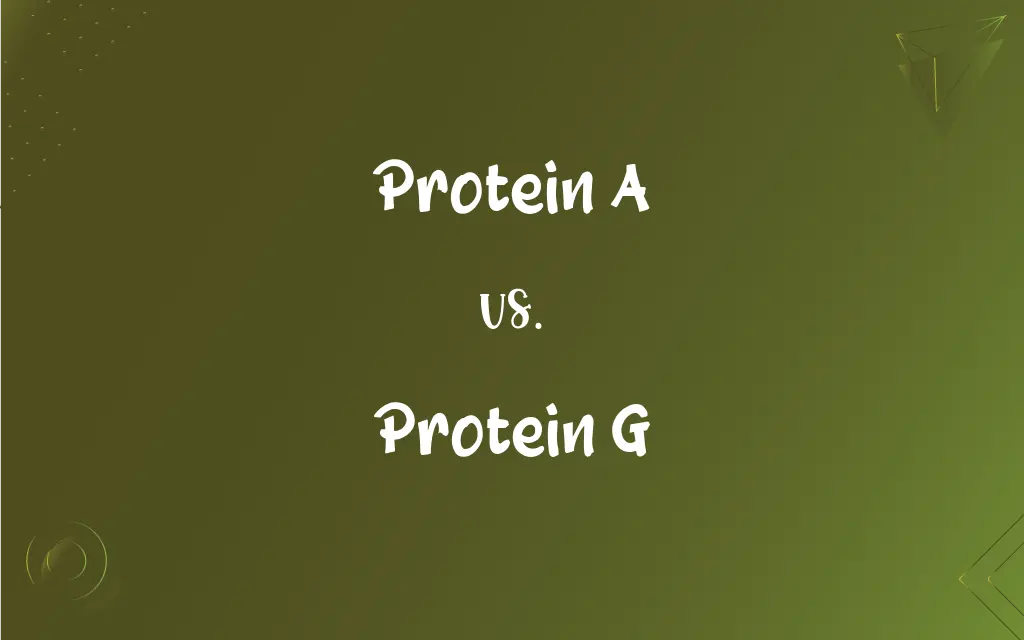Protein A vs. Protein G: What's the Difference?
Edited by Aimie Carlson || By Janet White || Published on January 29, 2024
Protein A binds to the Fc region of antibodies, especially IgG; Protein G also binds to the Fc region but has a broader range of antibody isotypes it can bind to.

Key Differences
Protein A, primarily found in the cell wall of Staphylococcus aureus, has a strong affinity for the Fc region of antibodies, particularly IgG. In contrast, Protein G, derived from Group C and G Streptococci, also binds to the Fc region of antibodies but exhibits a wider binding range, including IgA and IgM, in addition to IgG.
The binding specificity of Protein A is primarily towards human IgG1, IgG2, and IgG4. Protein G, on the other hand, shows a broader specificity, effectively binding to all human IgG subclasses and offering higher affinity for certain types of IgG than Protein A.
In biotechnological applications, Protein A is often used for antibody purification due to its specific interaction with IgG. Protein G, given its broader specificity, is favored in assays requiring binding to a variety of antibody isotypes or in cases where Protein A's affinity is inadequate.
The stability and binding conditions of Protein A and Protein G also differ. Protein A is less stable at low pH, which can be a limitation in some protocols. Protein G, in contrast, maintains stability and binding capacity across a broader range of pH levels, making it more versatile.
Both proteins are vital tools in immunology and biochemistry, Protein A's narrower specificity can be advantageous for targeted IgG isolation. Protein G's wider range of antibody interaction makes it a more flexible tool for capturing a diverse array of antibody isotypes.
ADVERTISEMENT
Comparison Chart
Source
Staphylococcus aureus
Group C and G Streptococci
Antibody Binding Affinity
High for IgG1, IgG2, IgG4
High for all IgG subclasses, IgA, and IgM
Binding Specificity
More specific to certain IgG subclasses
Broader specificity to various antibody types
Stability
Less stable at low pH
Stable across a wider pH range
Biotechnological Application
Preferred for specific IgG isolation
Used for broader antibody isotype purification
ADVERTISEMENT
Protein A and Protein G Definitions
Protein A
A cell wall component of certain bacteria, known for its antibody-binding properties.
Researchers use Protein A to detect specific antibodies in serum samples.
Protein G
A bacterial protein from Group C and G Streptococci, known for binding to various antibody isotypes.
Protein G's versatility is crucial in purifying diverse antibodies from serum.
Protein A
A protein leveraged for its strong affinity to human IgG subclasses in biochemical applications.
Protein A is integral in ELISA assays for capturing target IgG antibodies.
Protein G
A widely used tool in immunology for its ability to bind to all subclasses of human IgG.
In western blotting, Protein G is preferred for detecting multiple IgG subclasses.
Protein A
A protein from Staphylococcus aureus that binds specifically to the Fc region of IgG antibodies.
Protein A is used in immunoprecipitation to isolate IgG-bound antigens.
Protein G
A Streptococcal protein employed in antibody purification and detection due to its broad specificity.
Protein G coated beads are effective in immunoprecipitation assays.
Protein A
A biotechnologically important protein for selective immunoglobulin purification.
Affinity chromatography using Protein A efficiently purifies IgG from complex mixtures.
Protein G
A protein with a broad affinity for the Fc region of antibodies, including IgG, IgA, and IgM.
Protein G is used in immunoassays to capture a wide range of antibody types.
Protein A
A bacterial protein utilized in antibody purification and immunological assays.
Protein A columns facilitate the purification of monoclonal antibodies.
Protein G
A stable and versatile protein used in biotechnological applications for antibody interaction.
Due to its pH stability, Protein G is ideal for antibody purification under various conditions.
FAQs
What's the main use of Protein A?
Primarily used for specific IgG antibody purification.
How does Protein A bind to antibodies?
It binds to the Fc region of IgG antibodies.
What's the main use of Protein G?
Used for purifying a broad range of antibody types, including all IgG subclasses.
What is Protein G?
A protein from Group C and G Streptococci, with a broad affinity for various antibody isotypes.
Where is Protein G found naturally?
In Group C and G Streptococci.
How does Protein G bind to antibodies?
It has a broad binding range, including the Fc regions of IgG, IgA, and IgM.
Where is Protein A found naturally?
In the cell wall of Staphylococcus aureus.
Is Protein A stable at low pH?
It is less stable at low pH.
What is Protein A?
A bacterial protein from Staphylococcus aureus, binding to the Fc region of IgG antibodies.
Can Protein G bind to all IgG subclasses?
Yes, it binds to all human IgG subclasses.
What makes Protein G versatile in antibody binding?
Its broad specificity to various antibody types.
Is Protein G used in clinical diagnostics?
Yes, especially in assays requiring broad antibody detection.
How is Protein A important in biotechnology?
It's crucial for specific antibody purification and detection.
Can Protein A bind to all IgG subclasses?
It binds strongly to IgG1, IgG2, and IgG4.
Is Protein G stable at low pH?
It maintains stability across a wider pH range.
What is a common application of Protein A in research?
It's used in immunoprecipitation and ELISA assays.
What is a common application of Protein G in research?
It's used in a variety of immunoassays and antibody purification methods.
Is Protein A used in clinical diagnostics?
Yes, particularly in assays for specific IgG detection.
What makes Protein A specific in antibody binding?
Its specificity to certain IgG subclasses.
How is Protein G important in biotechnology?
It's versatile for purifying and detecting a wide range of antibodies.
About Author
Written by
Janet WhiteJanet White has been an esteemed writer and blogger for Difference Wiki. Holding a Master's degree in Science and Medical Journalism from the prestigious Boston University, she has consistently demonstrated her expertise and passion for her field. When she's not immersed in her work, Janet relishes her time exercising, delving into a good book, and cherishing moments with friends and family.
Edited by
Aimie CarlsonAimie Carlson, holding a master's degree in English literature, is a fervent English language enthusiast. She lends her writing talents to Difference Wiki, a prominent website that specializes in comparisons, offering readers insightful analyses that both captivate and inform.































































